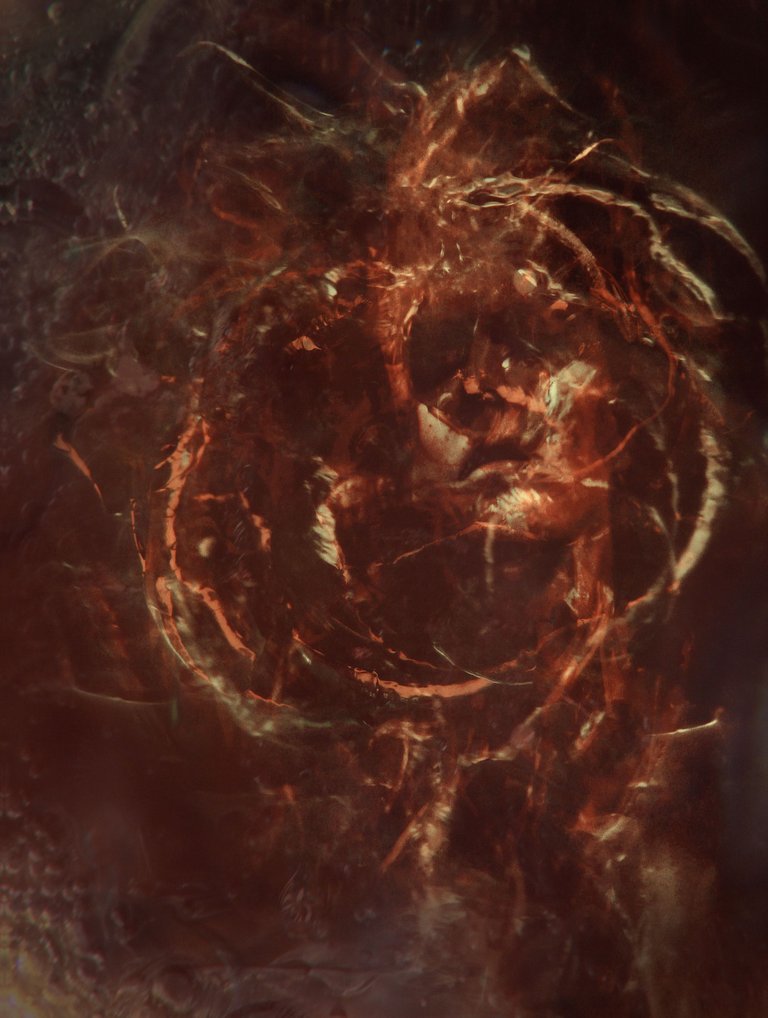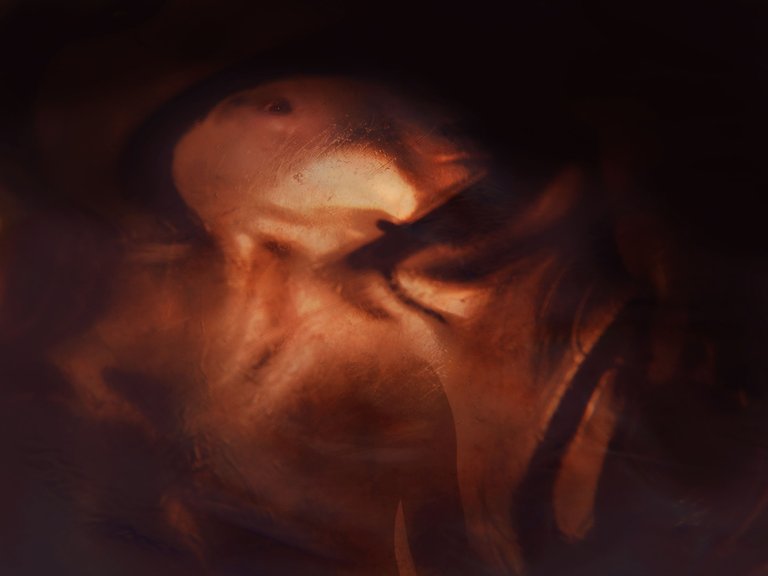It is often easy to understand what something is, by what it isn't. That's how we understand darkness, by its contrast to light. The abstract can also more easily be understood by what it isn't. In art, the abstract art is contrasted with art that replicates the world outside. Outside you have the things we know, and are familiar with, while inside you have an unrecognisable reality. In one sense abstract art is the art of the inside. Some may say that abstract art is a departure from reality, but it is rather capturing a deeper reality, a meta reality, a psychological reality.

You can divide abstract art into several categories. Two main categories are preconceived or automatic art, which also creates two very different perspectives in the process of making art. Where in one instance the person has the forms, and ideas already manifested in the mind, and where the technique and process only purpose is to manifest the image in the mind into existence outside. Automatic art on the other hand, is not preconceived, but is rather like a spontaneous flow, where the technique and material has as much a role in the production of the image, as the mental image the artist holds. In automatic art the pen and the paper can play a dynamic role in the creation of the image. How the ink moves on the paper, the wetness of it, how the paper absorbs it, all these details creates a starting point for the next line the artist contrive in the minds eye. This way of creating art forces you to be present, and be attentive to every action, and you are in a constant dialog between yourself and the material, and where every action creates new possibilities, and takes away others.

In the creation of abstract art there is a variance in the degree of control. From the conceived perfect control of every line, to drops flying onto a canvas and where you have little control of the movement of the paint and how it flows on the canvas. In this sense the abstract work, is like a exploration into the unknown, since you can’t preconceive the effects of your actions fully. By using chance as a factor in the image, it opens up the possibilities of creating new forms and ideas. Just like how a mutation works in evolution, a uncontrolled stain on a paper, can be the starting point of the form in the image, or it can be the destructive element that makes you start a new.

Viewing abstract art is often more challenging for people. This is because in order to get something out of it, you yourself have to put effort into it. Not just effort, but be in the right mental state. You have to be open to feel, and sense the forms, colours, lights, texture, layers, perspectives, and you yourself have to make sense out of it, to get something out of it, even if it is just a emotional feeling, or a deep insight. In this sense, what you see in abstract art is a mirror of yourself, how your unconsciousness and consciousness together makes sense of what you see, and what they make you feel. And by viewing art in this way, you will get to know yourself better.
.jpg)
The abstract in photography
The way we see the world, and how photography might change your perception.
“Purist” or edited.
When you cover the subject of making abstract art with a camera, there will be two distinct way of thinking about photography, which will guide the way you make your art. Which are those that have a purist/straight photography mindset, where editing of any kind is prohibited, and those that don’t put these restrictions on themselves. But no matter where you are in the gradient between editing, or non editing, photography is never a true reflection of reality, no matter how highly you wish to document what is “real”. The differences lies only in having the goal, or not having the goal, of representing reality as close to how it is see as possible. For many the idea of creating a picture without editing, is also a skill they might pride themselves on, while another might pride themselves on the possibilities of creation through the skill of editing. In the end the question becomes, what is more important, the journey or the destination, and only the one that walks the walk, can answer that for themselves.
A way of seeing
When you become interested in photography, you might notice more of the world, and start to look at the world more closely. If you get into street photography, you might start to be much more observant of what is going around you. When you walk around a city you notice people, you notice relationships, and interactions that you previously might have just walked past, not giving a second thought. If you get into nature photography, you might get a greater appreciation and understanding of the nature around you, from the small in macro photography, to the big in landscape photography, or the wild, in wildlife photography. Abstract photography, forces you to look at the world in a very different way, it changes your perspective, because in order to create abstract art, you need the creativity to see the object, and the world from new and interesting perspectives. In a way you need to be able to destroy the preconceived ideas of what something is, and then take something out of it, that becomes something of its own.
Known to unknown
In abstract art, there is always a gradient between the representation of the outside world, and the expression of the inside. A gradience between the known and the unknown. The more something is abstracted, the more it loses reference to the known. An example can be a photography of a tree, where you focus on the lines and shapes the branches make, yet you can clearly see it as tree branches. If you then take a picture of these branches as silhouettes, where the known textures are removed, or you take a picture of the shadows the branches throws onto a wall, the more the image is moving towards the unknown.

The “What is it?” question.
When it comes to abstract art in photography, as well as in other fields of abstract art, you will often be met with the question “What is it?” This question has often different meaning when it is directed at a photography, compared to a painting. When it is asked about a photography, it is often about the object that was photographed, while in a painting, it is often a deeper question about it’s meaning and what it represent. A reason for this might be because for a abstract painting the colours and forms, does not have a direct relationship with a real life physical object, while the abstract photography has. People will ask “what is this?” about a abstract photography because of their curiosity of knowing what it is a picture of. This curiosity is a natural impulse, from the way we are used to think about a camera and photography in general. Where a camera takes pictures of something, in order to document that something. But in abstract photography, there is no goal of trying to document something, or preserving the image of something for the future. So the answer to this question, has nothing to do with the image, other than it being a material that was abstracted to form the image. It is like asking a painter, “what is this ?” and getting the answer it is oil. For the painter the form was created by the use of the oil , and for the photographer the forms were taken out from the object that was photographed. The answer to these questions in abstract art, should be “what is it to you?” Because if the answer is “a tree”, the mind of the viewer will often stop there, not seeking to look further, and find more meaning in the image.

SteemAuto and upvote the posts, that I upvote.
And remember to do some charity when you are rich by contributing to me. Check out my Introduction PostUpvoted on behalf of @thehumanbot and it's allies. Write less but write great original content, and do not use bid bots for at least 1-2 days, for your post to be recommended to other curators. If you are using any image or video, cite proper source. Even if its your own image or video, it's worth mention the same. Great Original Works are rewarded by top Curators, refer posts from my Step-Brother @humanbot for more details.If you like this initiative, you can follow me in for more details. If you have any concerns or feedback with my way of operation, raise it with @sanmi , my operator who is freaking in Steemit chat or discord most of the time.
The Daily Sneak.Thanks to @sanmi, this post was resteemed and highlighted in today's edition of
Thank you for your efforts to create quality content!
Great write up. The images are a bit disturbing, but I suppose that is the intention - to leave the viewer uneasy, and with unanswered questions.
Thank you. There is no intention of the images being disturbing. The abstract can be unfamiliar, and unfamiliarity disturbes.
Well, the images leave unanswered questions (the unfamiliar nature) but also they generate strong interpretations of what they may represent. The disturbing factor derives not from the unfamiliar, but fromthe latter: the potential interpretations.
There are a class of 'psychic conflicts, suggested by these artstic representations' which most people are less familiar with, and for good reason. Beauty doesn't derive merely from the familiar either - something unfamiliar could potentially be beautiful. Something unfamiliar, also comforting and beautiful.
There is also the truth that analysis of a work of art as a representations of one person's experiences, may lead to the unfamiliar becoming understood. That often depends on the artist's willingness to reveal or conceal for whastever reason, those 'secrets'. As yet, the analysis is incomplete. To resteate, the reason for it being disturbing (which it is for me) goes a little beyond it being unfamiliar.
Thats nice and interesting to hear.